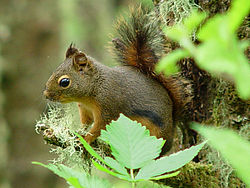From Wikipedia
Open on Wikipedia
| Mexican fox squirrel | |
|---|---|

| |
| Scientific classification | |
| Kingdom: | Animalia |
| Phylum: | Chordata |
| Class: | Mammalia |
| Order: | Rodentia |
| Family: | Sciuridae |
| Genus: | Sciurus |
| Species: | S. nayaritensis
|
| Binomial name | |
| Sciurus nayaritensis J. A. Allen, 1890
| |
| Subspecies[3] | |
| |

| |
| Mexican fox squirrel's range | |
The Mexican fox squirrel (Sciurus nayaritensis) is a species of tree squirrel found throughout the Sierra Madre Occidental of Mexico as far south as Jalisco — and northward into the Chiricahua Mountains of southeastern Arizona, U.S.[4]
This species, or its subspecies, is sometimes called the Nayarit, Apache, or Chiricahua fox squirrel.[4] It has been evaluated as an IUCN Red List Least Concern species.[1]
Description
[edit]Physical
[edit]The Mexican fox squirrel has a grizzled brown back with a yellow to rufous underside, and a charcoal tail frosted with white. Two molts occur each year; the winter pelage is more rufous and the scrotum is often ringed with white.[5] Mass is approximately 700 grams (25 oz).[6]
Behavior
[edit]Mexican fox squirrels are diurnal, non-territorial,[7] and do not hibernate during the winter months.[8]
- Food sources
The Mexican fox squirrel forages extensively on the ground and in the forest canopy for tree seeds, flowers, and fungi. Seeds from the cones from pine, Douglas fir, and true firs are extracted by removing individual cone scales. Acorns and walnuts are also eaten when available, along with a variety of other tree seeds, hypogeous and occasionally epigeous fungi, and insects.[9] Mexican fox squirrels occasionally cache large seeds by scatter-hoarding them in leaf litter and topsoil.[5]
The ecology of the Mexican fox squirrel has not been studied thoroughly, particularly outside the United States. Densities are often very low.[10] Large raptors, canids, felids, procyonids and snakes are likely the major predators.[11]
Mexican fox squirrels typically produce a single small litter of 1 or 2 young in late spring or summer.[10] Mexican fox squirrels nest in ball-shaped dreys composed of sticks and leaves in trees; cavities within large trees are occasionally used, especially by nursing females. They are known to communally nest at times. Mexican fox squirrels are notably silent and appear to prefer to seek cover and remain motionless. If startled, they may bark and chuck from safe locations in trees.[5]
Habitat
[edit]Mexican fox squirrels are found in forests ranging from low elevation (~1,500 metres [ 4,900 ft ]) Madrean forests with a mixture of pine and oak to higher elevation mixed conifer forests < 2,700 metres [ 8,900 ft ].[12] Riparian areas with large cottonwoods and sycamores often harbor the highest densities. In the United States, the squirrel lives only in the Chiricahua Mountains of southeastern Arizona.[13]
The Mexican fox squirrel inhabits forests that were historically maintained by frequent, low-severity fire, and uses areas with open understory and large trees that are typical of such forests.[14]
Subspecies
[edit]There are three subspecies:[5]
- S. n. nayaritensis (Nayarit fox squirrel): southern portion of the distribution range. This is a smaller and more yellowish subspecies.
- S. n. apache (Apache fox squirrel): northern and central portion of the distribution range. This is a subspecies intermediate in size and color.
- S. n. chiricahuae (Chiricahua fox squirrel): an endemic subspecies of the Chiricahua Mountains of southeastern Arizona, U.S. Characterized as more reddish throughout.
See also
[edit]- Fire ecology
- Sierra Madre Occidental pine-oak forests — ecoregion
References
[edit]- ^ a b Cassola, F. (2017) [errata version of 2016 assessment]. "Sciurus nayaritensis". IUCN Red List of Threatened Species. 2016: e.T20015A115155124. doi:10.2305/IUCN.UK.2016-3.RLTS.T20015A22247142.en. Retrieved 15 June 2024.
- ^ "Sciurus nayaritensis". Natureserve Explorer. Retrieved 12 May 2024.
- ^ Thorington, R.W. Jr.; Hoffmann, R.S. (2005). "Family Sciuridae". In Wilson, D.E.; Reeder, D.M (eds.). Mammal Species of the World: a taxonomic and geographic reference (3rd ed.). The Johns Hopkins University Press. pp. 754–818. ISBN 978-0-8018-8221-0. OCLC 26158608.
- ^ a b Best, T.L. (1995) Sciurus nayaritensis. Mammalian Species 492, 1-5.
- ^ a b c d Thorington, R.W., Jr., Koprowski, J.L., Steele, M.A., and Whatton, J. (2012) Squirrels of the World. Johns Hopkins University Press, Baltimore, 472 pp.
- ^ Pasch, B.S., Koprowski, J.L. (2006a) Annual cycles in body mass and reproduction of Chiricahua fox squirrels (Sciurus nayaritensis chiricahuae). Southwest. Nat. 51, 531-535.
- ^ Pasch, B.S., Koprowski, J.L. (2006b) Sex differences in space use of Chiricahua fox squirrels. J. Mammal. 87, 380-386.
- ^ Koprowski, J.L., Corse, M.C. (2005) Time budgets, activity periods, and behavior of Mexican fox squirrels. J. Mammal. 86, 947-952.
- ^ Koprowski, J.L., Corse, M.C. (2001) Food habits of the Chiricahua fox squirrel (Sciurus nayaritensis chiricahuae). Southwest. Nat. 46, 62-65.
- ^ a b Pasch, B.S., Koprowski, J.L. (2005) Correlates of vulnerability in Chiricahua fox squirrels, in: Gottfried, G.J., Gebow, B.S., Eskew, L.G., Edminster, C.B. (Eds.), Proceedings: Connecting mountain islands and desert seas: biodiversity and management of the Madrean archipelago II. USDA Forest Service, Gen. Tech. Rep. RMRS-P-36, Rocky Mountain Research Station, Fort Collins, CO, pp. 426-428.
- ^ Kneeland, M.C., Koprowski, J.L., and Corse, M.C. (1995) Potential predators of chiricahua fox squirrels (Sciurus nayaritensis chiricahuae). Southwest. Nat. 40, 340-342.
- ^ Hoffmeister, D.F. (1986) Mammals of Arizona. The University of Arizona Press, pp. 212-213.
- ^ Brown, D.E. (1984) Arizona's tree squirrels. Arizona Game and Fish Department, pp. 39-61.
- ^ Doumas, Sandra L.; Koprowski, John L. (2013). "Return of Fire as a Restoration Tool: Long-Term Effects of Burn Severity on Habitat Use by Mexican Fox Squirrels". Restoration Ecology. 21 (1): 133–139. Bibcode:2013ResEc..21..133D. doi:10.1111/j.1526-100X.2012.00864.x. S2CID 53664867.




